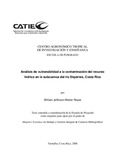Análisis de vulnerabilidad a la contaminación del recurso hídrico en al subcuenca del río Siquirres, Costa Rica
Date
2008Author
Watler Reyes, William J.
xmlui.dri2xhtml.METS-1.0.item-location
Turrialba, Costa Rica
Type
Tesis
Metadata
Show full item recordDescription
Tesis (Mag.) -- CATIE, 2008
Abstract
El estudio se realizó en la subcuenca del río Siquirres, perteneciente a la cuenca del río Pacuare en el Distrito Primero, del Cantón de Siquirres y Tercero de la provincia de Limón, Región IV Huetar Atlántico, Costa Rica. Con el objetivo de analizar la vulnerabilidad a la contaminación del recurso hídrico la cual integre el aspecto legal, el conocimiento técnico-científico y el local. Como resultado se obtuvo, un área de estudio de 10,4 km2 (18,8% del área total). La zona I (2,4 km2), con una caracterización de alta vulnerabilidad global a la contaminación superficial (60,76%) y la zona II (4,05 km2), con una lamina de recarga de agua subterránea > 2000 mm/año y una vulnerabilidad media a la contaminación del acuífero, con rangos de 0,34 - 0,49. Un índice de calidad de agua cruda del río Siquirres de regular (54,47), donde sobresalen los parámetros coliformes fecales, DBO5, turbidez, por la falta de una planificación urbana, sistema de alcantarillados de aguas negras y/o servidas, educación ambiental, asimismo por el cambio en el uso del suelo, la existencia de Ganadería en la ribera del río, pequeños establos de porquerizas y basureros ilegales, como los indicadores responsables de la contaminación actual. This study was done in the Rio Siquirres subwatershed located in the Siquirres district at the Limon Province in Costa Rica. The main objective of the research was to analyze the integrated vulnerability of water to pollution from several points of view: legal, technical and local. This analysis allowed to conclude that the zone I has a high risk to water resources pollution, mainly due to an unplanned urban development expansion, inappropriate landuse and a lack of a solid and liquid waste disposal program. Also, it allowed to identify areas with more than 2000 mm of groundwater recharge which were named as Zone II. The third outcome, was the superficial and groundwater pollution vulnerability using the ICA methodology (superficial) and GOD methodology (groundwater). Results showed that superficial water has still a regular quality but the quantity of fecal coliforMON, BOD5, and turbidity are above the allowed levels and this fact makes the water not suitable for drinking, unless it is potabilized. Also, the GOD analysis showed the groundwater pollution risk is medium in most of the area.
Keywords
Publisher
Centro Agronómico Tropical de Investigación y Enseñanza (CATIE)
URI (Permanet link to cite or share this item)
https://repositorio.catie.ac.cr/handle/11554/4454Collections
- Tesis [3111]


